中职英语拓展模块教案第一周
- 格式:doc
- 大小:58.04 KB
- 文档页数:7
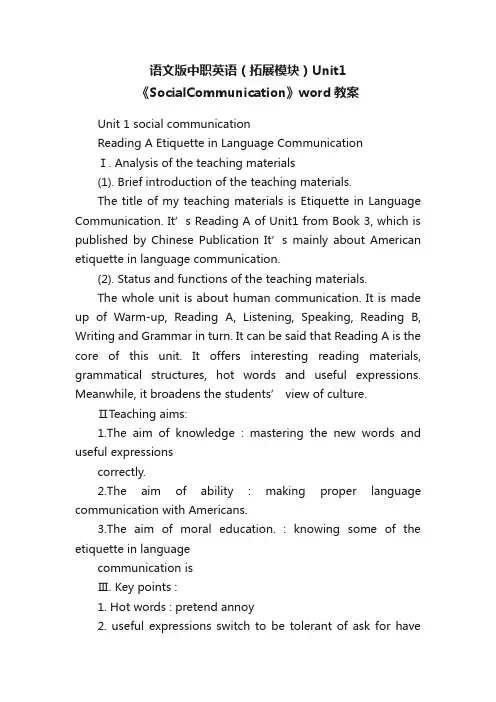
语文版中职英语(拓展模块)Unit1《SocialCommunication》word教案Unit 1 social communicationReading A Etiquette in Language CommunicationⅠ. Analysis of the teaching materials(1). Brief introduction of the teaching materials.The title of my teaching materials is Etiquette in Language Communication. It’s Reading A of Unit1 from Book 3, which is published by Chinese Publication It’s mainly about American etiquette in language communication.(2). Status and functions of the teaching materials.The whole unit is about human communication. It is made up of Warm-up, Reading A, Listening, Speaking, Reading B, Writing and Grammar in turn. It can be said that Reading A is the core of this unit. It offers interesting reading materials, grammatical structures, hot words and useful expressions. Meanwhile, it broadens the students’ view of culture.ⅡTeaching aims:1.The aim of knowledge : mastering the new words and useful expressionscorrectly.2.The aim of ability : making proper language communication with Americans.3.The aim of moral education. : knowing some of the etiquette in languagecommunication isⅢ. Key points :1. Hot words : pretend annoy2. useful expressions switch to be tolerant of ask for havetrouble (in)doing/with sth. Leave out now that3. etiquette in language communicationⅣ: Difficult points:mastering the hot words and useful expressions and putting the knowledge of etiquette in language communication into reality.Ⅴ:Conditions of the students.The students of our vocational high school are poor in fundamental English comparatively. As a result, most of them have much less interest in learning English. But they are active in taking part in activities. Their destination of studying English is to develop necessary abilities needed in their work and lives.ⅥTeaching and learning methods.1. Teaching methods:elicitation method, encouraging method, explaining method and situational method.2. learning methods :3. exploring, participating and practicing methodsⅦ: Teaching Design:carry on this lesson in six steps: lead-in, fast reading, intensive reading, practice, summary and homework, which take 2 minutes, 5 minutes, 20 minutes, 15 minutes, 2 minutes and 1 minutes respectively. Before I end this pa rt, I’d like to display my design of writing on the blackboard.ⅧTeaching procedure:Step 1 Lead in (2’)Tell a story , showing some pictures with wrong manners → Find mistakesThen ask the question: “What are wrong manners?”The students needn ’t answer t he question Step 2 fastreading (5)read fast → showing the pictures again → give their answers Then ask the question: “What we should say/do here?”× ① ×② × ③ ×④Step 3 Intensive reading (20)1. read carefully ,then ask the question: “Why should we beha ve so?”2. key words and useful expressions → long sentences → expansionKey words and expressions:ok ① ok②①② ?④ ?③③ ok ③ ok④In this step, I’ll take three steps to present the key words and useful expressions. First, the usage. Then, show one or two model sentences. Last, to get the students to participate and practise, give them one or two sentences as exercises. The exercises can be in different forms, such as, filling in blanks, translating, correcting mistakes, and so on. All the exercises are done by the students themselves.be tolerant of/towards:Usage: be tolerant of/towards +n./ pron .Model sentences:1.Mr. Smith is not very tolerant of/towards others .2.We should always be tolerant of the views of others even if we disagree with them. Exercises:1.Fill in the blank with the right form of the given words:Her own mistakes made her very____( tolerant) of/towards others.Have some/no trouble(in)…Usage: have some/no trouble(in) doing sth.Model sentences:I had some trouble (in) reading the letter . His handwriting is very bad.They had no difficulty in understanding what he said.Exercises:Translate the Chinese sentence into English:他们毫不费力就找到了我的家。
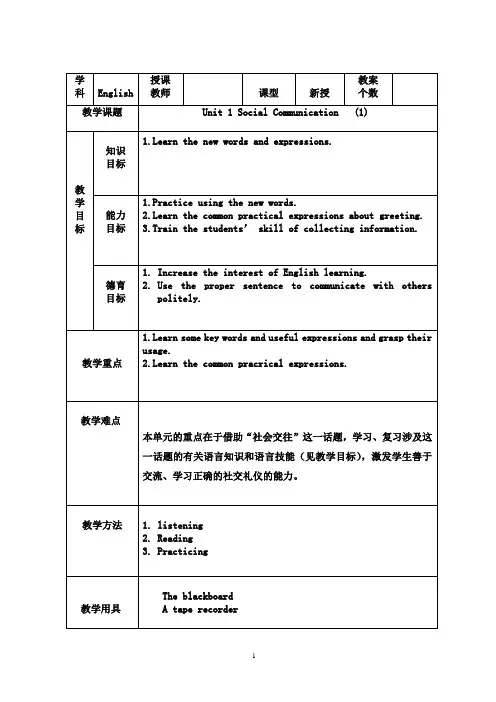

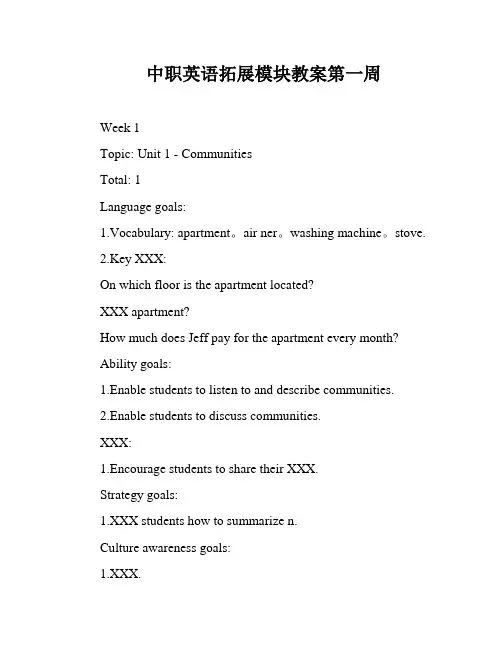
中职英语拓展模块教案第一周Week 1Topic: Unit 1 - CommunitiesTotal: 1Language goals:1.Vocabulary: apartment。
air ner。
washing machine。
stove.2.Key XXX:On which floor is the apartment located?XXX apartment?How much does Jeff pay for the apartment every month? Ability goals:1.Enable students to listen to and describe communities.2.Enable students to discuss communities.XXX:1.Encourage students to share their XXX.Strategy goals:1.XXX students how to summarize n.Culture awareness goals:1.XXX.XXX:1.ListeningXXX and methods:Step 1:XXX's activities:Ask students how their week was and if they have any XXX.XXX.Have students read and XXX they have done before in Activity 1.Students' activities:XXX.XXX.Read and XXX they have done before in Activity 1.XXX: 5 minutes.How many bedrooms does the apartment have。
What can Jeff see from the apartment。

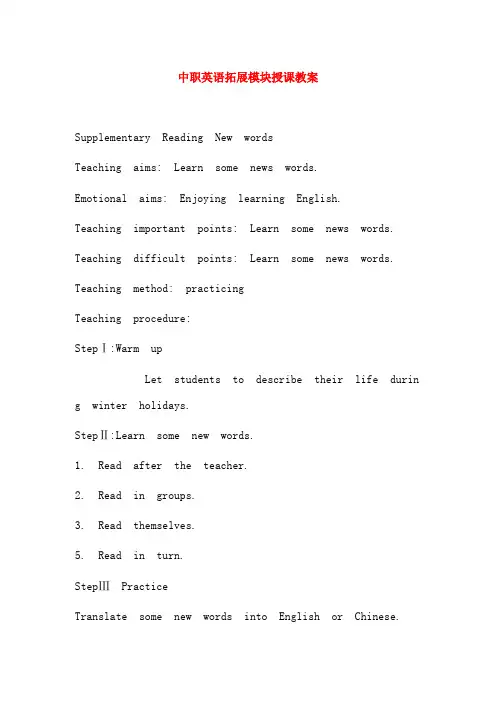
中职英语拓展模块授课教案Supplementary Reading New wordsTeaching aims: Learn some news words.Emotional aims: Enjoying learning English.Teaching important points: Learn some news words. Teaching difficult points: Learn some news words. Teaching method: practicingTeaching procedure:StepⅠ:Warm upLet students to describe their life durin g winter holidays.StepⅡ:Learn some new words.1. Read after the teacher.2. Read in groups.3. Read themselves.5. Read in turn.StepⅢPracticeTranslate some new words into English or Chinese.StepⅣSummary and homework Recite news words. Teaching thinking: Students are active in class, and they can react to the teacher.Blackboard design: Some word formation.Supplementary ReadingTeaching aims: 理解文章的基本内容Emotional aims:克服学习中的困难Teaching important points: 掌握教学目标中的Key words和useful Expressions的基本用法Teaching difficult points: 掌握教学目标中的Key words和useful Expressions的基本用法Teaching method: practicing and reading.Teaching procedure:StepⅠRevisionReview some words.StepⅡReading1. Read the text carefully in a few minutes discuss in groups and answer in turn.2. Answer the following questions.What is the body language/nonverbal communication? StepⅢKey words和Useful Expressions①We commumcate with each other by means of language.我们通过语言相互交流。

中职英语高教社拓展模块Title: The Importance of English in Vocational Education.In the realm of vocational education, English holds a pivotal position. As the global language, English acts as a bridge connecting people from diverse cultures and backgrounds. In the modern world, where technology and information flow freely, English has become an essential tool for communication, learning, and professional success.Firstly, the role of English in vocational education cannot be overstated. Vocational courses aim to equip students with practical skills and knowledge necessary for specific occupations. English, being the language of international communication, is essential for understanding and accessing global industry standards, technologies, and best practices. It enables students to read and understand technical manuals, operate software and equipment, and communicate effectively with colleagues and clients.Secondly, English is a gateway to further education and career opportunities. Vocational students often aspire to upgrade their skills or pursue higher education. English proficiency opens doors to a wide range of educational institutions and courses, enabling students to expand their horizons and enhance their employability. Additionally, many international companies prefer candidates who are proficient in English, as it enables them to work effectively in cross-cultural teams and markets.Moreover, English is a vehicle for personal and intellectual growth. Through reading, writing, speaking, and listening, students develop critical thinking, analytical skills, and cultural awareness. These skills are invaluable in today's interconnected world, where problem-solving and adaptability are paramount.However, it's important to recognize that English education in vocational settings should be relevant and engaging. Students should be encouraged to use English in practical contexts, such as simulating workplace scenariosor reading industry-related materials. This approach not only makes learning more meaningful but also enhances students' motivation and engagement.In conclusion, English is a crucial component of vocational education. It empowers students to access global knowledge, pursue further education, and enhance their career prospects. Vocational institutions should prioritize English education, making it relevant, engaging, and accessible to all students. By doing so, they can prepare their students not only for the demands of the current job market but also for the challenges of the future.。
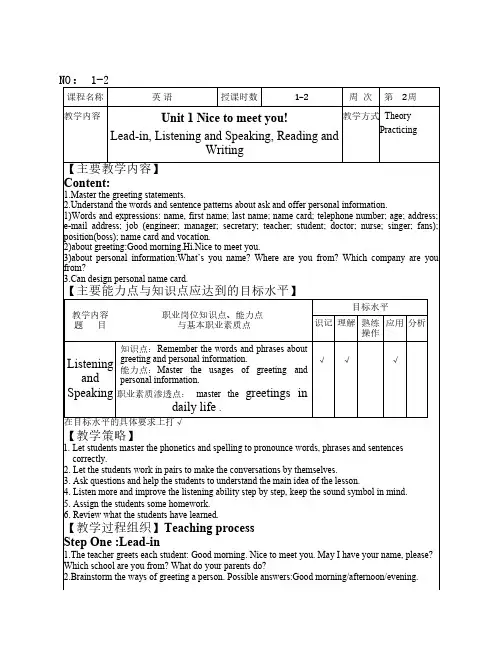

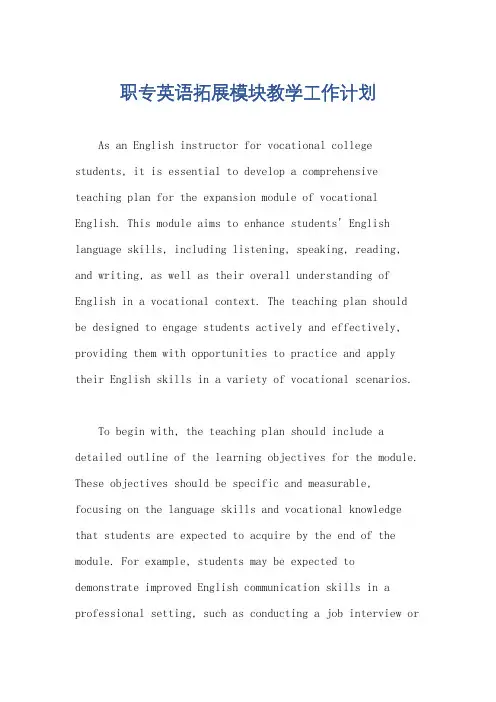
职专英语拓展模块教学工作计划As an English instructor for vocational college students, it is essential to develop a comprehensive teaching plan for the expansion module of vocational English. This module aims to enhance students' English language skills, including listening, speaking, reading, and writing, as well as their overall understanding of English in a vocational context. The teaching plan should be designed to engage students actively and effectively, providing them with opportunities to practice and apply their English skills in a variety of vocational scenarios.To begin with, the teaching plan should include a detailed outline of the learning objectives for the module. These objectives should be specific and measurable, focusing on the language skills and vocational knowledge that students are expected to acquire by the end of the module. For example, students may be expected to demonstrate improved English communication skills in a professional setting, such as conducting a job interview ordelivering a presentation. Additionally, students should be able to comprehend and produce written texts related to their vocational field, such as reports, emails, and technical documents.In addition to outlining learning objectives, the teaching plan should also include a variety ofinstructional strategies and activities to engage students in active learning. This may involve incorporating real-world vocational materials, such as industry-specific articles, videos, and case studies, into the curriculum. Furthermore, the plan should incorporate opportunities for students to practice their English skills in authentic vocational contexts, such as role-playing customer service scenarios or participating in group discussions about workplace issues.Moreover, the teaching plan should address the assessment of students' learning outcomes. This may involve designing both formative and summative assessments to measure students' progress throughout the module. For example, formative assessments could include regularquizzes, presentations, and group projects, while summative assessments could consist of a final exam and a comprehensive vocational English project. By incorporatinga variety of assessment methods, instructors caneffectively evaluate students' English proficiency and vocational knowledge.Furthermore, the teaching plan should consider the diverse needs and learning styles of vocational college students. This may involve implementing differentiated instruction to accommodate students with varying English proficiency levels and vocational backgrounds. For instance, instructors may provide additional support for students who are struggling with English language skills, such asoffering one-on-one tutoring or providing supplementary materials for independent study. Additionally, instructors should create a supportive and inclusive learning environment that encourages students to activelyparticipate and collaborate with their peers.In conclusion, developing a comprehensive teaching plan for the expansion module of vocational English is crucialfor providing vocational college students with the necessary language skills and vocational knowledge fortheir future careers. By outlining clear learning objectives, incorporating engaging instructional strategies, assessing students' learning outcomes, and accommodating diverse learning needs, instructors can create an effective and meaningful learning experience for students. Ultimately, the goal of the teaching plan is to empower students to communicate confidently and effectively in English within a vocational context, preparing them for success in their future careers.。
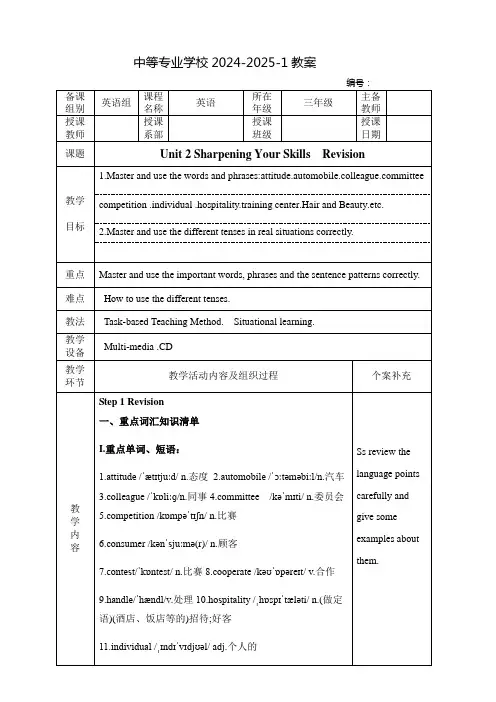
中职英语拓展模块教师用书【第一章】教学目标与要求中职英语拓展模块作为一门扩展学科,旨在帮助学生提高英语综合应用能力,拓宽知识面,培养学生的跨学科思维和解决问题的能力。
因此,教学目标和要求如下:1. 提高学生的英语口语表达能力,使学生能够准确、流利地用英语进行日常交流。
2. 培养学生的阅读理解能力,使学生能够理解和分析各类英语文章。
3. 培养学生的写作能力,使学生能够独立完成各类英语写作任务。
4. 拓宽学生的英语知识面,包括语法、词汇、文化等方面。
5. 培养学生的听力理解能力,使学生能够听懂并理解日常生活中的英语对话和讲座。
【第二章】教学内容及教学方法中职英语拓展模块的教学内容涵盖口语、阅读、写作和听力四个方面。
为了更好地实现教学目标,教师可以采用以下教学方法:1. 口语教学:通过课堂演讲、小组讨论和角色扮演等活动,让学生在真实的语境中进行口语练习,提高口语表达能力。
2. 阅读教学:教师可以选择具有代表性的英文文章和材料,引导学生进行精读和泛读,提高阅读理解能力。
3. 写作教学:教师可以设计各类写作任务,如图表描述、文章写作等,鼓励学生进行写作练习,提高写作能力。
4. 听力教学:通过播放英语对话、讲座等录音材料,让学生进行听力训练,提高听力理解能力。
【第三章】教学资源与评估方式为了支持教师的教学工作,我们提供了以下教学资源:1. 教材和教辅材料:为中职英语拓展模块开发了一套教材和相关教辅材料,内容包括口语练习、阅读理解、写作和听力训练等。
2. 多媒体教具:提供了多媒体课件、录音材料等,以帮助教师更好地展示和解释教学内容。
3. 在线学习平台:搭建了在线学习平台,供学生进行自主学习和练习。
教学评估是衡量学生学习成果的重要手段,我们提供了以下评估方式:1. 日常表现评估:教师通过观察学生的课堂参与度、作业完成情况等来评估学生的日常表现。
2. 期中期末考试:设置期中期末考试,对学生的口语、阅读、写作和听力进行综合评估。
最新中职英语拓展模块授课教案:Unit1SocialCommunication中职英语拓展模块授课教案Unit1 Social CommunicationNew wordsTeaching aims: Learn some news words.Emotional aims: Enjoying learning English.Teaching important points: Learn some news words. Teaching difficult points: Learn some news words. Teaching method: practicing Teaching procedure:StepⅠ:Warm upLet students to describe their life durin g winter holidays.StepⅡ:Learn some new words.1. Read after the teacher.2. Read in groups.3. Read themselves.4. Read in turn.StepⅢPracticeTranslate some new words into English or Chinese.StepⅣSummary and homework Recite news words. Teaching thinking: Students are active in class, and they can react to the teacher.Blackboard design: Some word formation.native pretend misunderstand communicate meanscontact soap admitpolitely engagewave shake explainrude lostrather finger formswitch conversationsymbol consider tasteface wheneverpresident thus properaudience overviewWarming upTeaching aims: Learn some news words.Emotional aims: Learn some manners in language commu nication.Teaching important points: Discuss some questions. Teaching difficult points: Learn some news words. Teaching method: practicing and discussing.Teaching procedure: StepⅠRevisionReview some words.StepⅡDiscussion 讨论课文插图Now look at the picture in the reading text "Etiquette in Language Communication".What can you see in it?-From the picture, we can see a woman is t alking with a man. But the manlooks a bit uneasy, maybe he is nervous. Obviously it's not a smooth language communication.StepⅢ提示相关生词和短语,如:native speaker, native language, have trouble in doi ng sth, pretend to do sth, repeat, explain, manneStepⅣ分组讨论下面的3个问题,要求学生用英语如实回答:1) Have you ever talked with an English native spe aker?2) What would you do when you don't know how to say something in English?3) What would you do when you don't understand oth ers inEnglish?StepⅤSummary and homework Recite news words. Teaching thinking: Students are active in class, and they can react to the teacher.Blackboard design:native speaker,native language,have trouble in doingTeaching aims: 理解文章的基本内容Emotional aims:享受学习英语的乐趣Teaching important points: 掌握教学目标中的Key words和useful Expressions的基本用法Teaching difficult points: 掌握教学目标中的Key words和useful Expressions的基本用法Teaching method: practicing and reading.Teaching procedure:StepⅠRevisionReview some words.StepⅡReadingAnswer the following questions.(1)Why are foreigners usually tolerant of non - nat ive speakers' English?(2)Why is it rude to talk with a person in your native language and leave your American friends stan ding there?带着问题用3-4分钟时问快速阅读课文,了解要求掌握的信息。
第一周Topic Unit 1 Communities Total1 Language goals1. Words & expressions:the apartment,Air conditioner. Washingmachine.Stove.2.Key sentences:Which floor is the apartment on?What is provided in the apartment?How much does the apartment cost Jeff every month?Ability goalsEnable the students to listen to materials that describe Communities.Enable the students to talk about Communities.Emotion & attitude goalsEnable the students to share their happiness withothers Strategy goalsLearn how to summarize informationCulture awareness goalsLearn the western attitude about Communities.Teaching important pointsListeningTeaching procedures and waysSteps Teacher’s activities Students ’ activities Teaching TimereferenceStep11T:How was your answer the questions Brainst5min Lead in Communities. 2.Learn the new words orming s the activities that and phrases.Ss talk about and read and tick theteach the phrases in activities they didActivity 1before in Activity 1Step21. Play the tape and 1.Ss read the sentences Tape5min Listenin get the Ss to finish and get the meaning of recordi sg Activity2each sentence.ng2.Ss listen and match.Step3Which floor is the 1.Look and talk about Tape12 Listenin apartment on?the pictures.recordi mins g What is provided in 2.Ss listen and tick .ng&the apartment? 3.Ss listen to the tapespeaking Howmanybedrooms does and finish Activity2the apartment have? 4. Ss repeat after theWhat can Jeff see from tapethe apartment? 5.Ss retell theHow much does the dialogue.apartment cost Jeffevery month?2. Check their workStep 4their answers Ss choose the right Role-pl10 Reading 2. Walk around the answers aying mins classroom and offerhelp if necessary.Step 5Walk around the Ss make conversations Role-pl10 Practice classroom and offer aying mins help if necessary.Step 6Give marks to each Ss talk about their2 Assessin group.performance mins gHomework Wb P1-3 EX1,2,3Blackboard Unit 1 CommunitiesdesignWhich floor is the apartment on?What is provided in the apartment?How many bedrooms does the apartment have?What can Jeff see from the apartment?How much does the apartment cost Jeff every month?Summarie s Students were not used to studying after a long winterThey didn ’t concentrate on lessons. So this lesson is not successful.vacation.Topic Unit 1 Communities Total2 Language goals1.Words & expressions:swallows dustbins ensure Property Management Center rubbish-sorting brochures2.Key sentences:swallows his breakfast and rushes to the dustbins beside the gate ofhis community. Four other playmates are waiting for him there to check the rubbish and to ensure it is sorted correctly.3.Ability goalsEnable the students to read the materialsEnable the students to talk about the story.Emotion & attitude goalsEnable the students to share their happiness with othersStrategy goalsLearn how to summarize informationCulture awareness goalsLearn the western attitude about Communities.Teaching important pointsRead the materials.Teaching procedures and waysSteps Teacher’s activities Students ’ activities Teaching TimereferenceStep 11T:How was your 1.Read and match Brainst5min Lead in Communities. 2.Learn the new words orming s the activities that and phrases.Ss talk about and 3.Ss read and matchteach the phrases in For Sale WantedActivity 6Notice Join Us,1,2,3Right NowStep21. Play the tape and Listenin get the Ss to finish g Activity7Step3Listening 1. Ss read the sentences Tape5min and get the meaning of recordi s each sentence.ng1. Look and talk about Tape12 the pictures.recordi mins2. Ss listen and choose.ng& 2. Check their work 3.Ss readspeaking 4.Ss repeat after thetape5. Ss retell the storyStep 4their answers Ss choose the right Role-pl10 Reading 2. Walk around the answers aying mins classroom and offerhelp if necessary.Step 5Walk around the Ss make conversations Role-pl10 Practice classroom and offer aying mins help if necessary.Step 6Give marks to each Ss talk about their2 Assessin group.performance mins gHomework Activity8Blackboard Unit 1 CommunitiesdesignAll of the buildings are equipped with three dustbinsThey handed out ___________________________________They explained _____________________________________Summarie Students were not used to studying s g winter vacation. They didn ’t concentratelesson is not successful.afteron lessons.a lonSo thisTopic Unit 1 Communities Total3 Language goals1.Words & expressions:donated ,put up ,performance,move2.Key sentences:After supper, Jerry and his friends beganJerry and his friends have toJerry and his classmates planned toAbility goalsEnable the students to read the materialsEnable the students to talk about the story.Emotion & attitude goalsEnable the students to share their happiness with othersStrategy goalsLearn how to summarize informationCulture awareness goalsLearn the western attitude about Communities.Teaching important pointsWritingTeaching procedures and waysSteps Teacher’s activities Students ’ activities Teaching TimereferenceStep11T:How was your 1.Read and match Brainst5min Lead in Communities. 2.Learn the new words orming s the activities that and phrases.Ss talk about andteach the phrases inActivity 6,1,2,3Step21. Play the tape and 1.Ss read the sentences Tape5min Look and get the Ss to finish and get the meaning of recordi s complete Activity9each sentence.ng. 2.Look and completeStep3 1.Look and talk about Tape12the pictures.recordi mins2.Ss listen and choose.ng2. Check their work3.Ss read4. Ss repeat after thetape5. Ss retell the storyStep 4their answers Ss write out the right Role-pl102. Walk around the answers aying minsclassroom and offerhelp if necessary.Step 5Walk around the Read and complete.Role-pl10 Practice classroom and offer aying mins help if necessary.Step 6Give marks to each Ss talk about their2 Assessin group.performance mins gHomework Activity8Blackboard Unit 1 CommunitiesdesignAfter supper, Jerry and his friends began _____________Jerry and his friends have to________________Jerry and his classmates planned to___________Summarie Students were not used to studying s g winter vacation. They didn ’t concentratelesson is not successful.afteron lessons.a lonSo this。